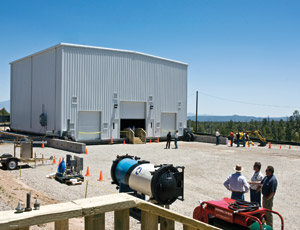Los Alamos National Laboratory began demolishing a cluster of 65-year-old buildings that once housed the world’s first full-scale plutonium processing line. ARSEC Environmental LLC, of White Rock, N.M., won a $2-million task order in April to perform this work.

The buildings, known as “DP West,” housed plutonium processing for nuclear warheads from late 1945 through 1978. They are the second generation of Lab buildings, replacing those built during World War II for the Manhattan Project. DP West is located within the Lab’s historic Technical Area 21.
The work is part of the $212 million of ARRA funding to advance and accelerate cleanup efforts around the Department of Energy’s weapons complex. Since last year, the Lab has demolished 13 of 24 planned structures and completed several groundwater monitoring wells. After demolition is complete, crews will analyze and remediate the concrete slabs and soils remaining, as part of the Consent Order on cleanup with the state of New Mexico.
The buildings at DP West were arranged as wings off a central hallway and served as a sort of assembly line, where plutonium in a liquid solution—produced at the Hanford Plant in Washington—was extracted, processed into metal form, and shaped into cores for nuclear weapons.
LANL also began the $90-million excavation and clean-up of a World War II-era landfill at the Trinity atomic bomb test—the world’s first test of an atomic weapon. Crews will scoop out 22,000 cu yds of trash and dirt—enough to cover a football field to a depth of about 11 ft—and fill the excavated areas with clean soil that meets residential standards.
The six-acre landfill, known as Material Disposal Area B, contains a series of trenches used from 1944 to 1948 to dispose of hazardous and non-hazardous trash from Manhattan Project labs and buildings.
Despite the original purpose of the landfill, cleanup crews do not expect to find much radioactive material. Plutonium was extremely rare, and soil cores taken last year estimate that between three and seven ounces of plutonium are scattered across the site. However, an entire truck from the Trinity site may be buried in MDA B.
The landfill is located within the Lab’s historic Technical Area 21 and right across the street from several Los Alamos businesses, prompting extra safety precautions at the site. To prevent dust migration and to isolate the waste during digging, all excavation will take place inside 13 sturdy metal buildings equipped with air filtration, remote cameras, chemical sensors, and fire suppression systems.
Idaho Falls, Idaho-based Portage Inc. is on track to complete the work by December.

Post a comment to this article
Report Abusive Comment